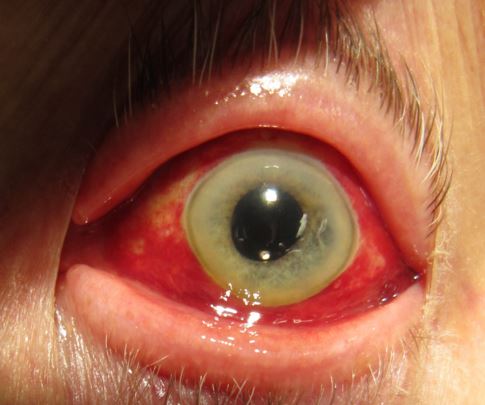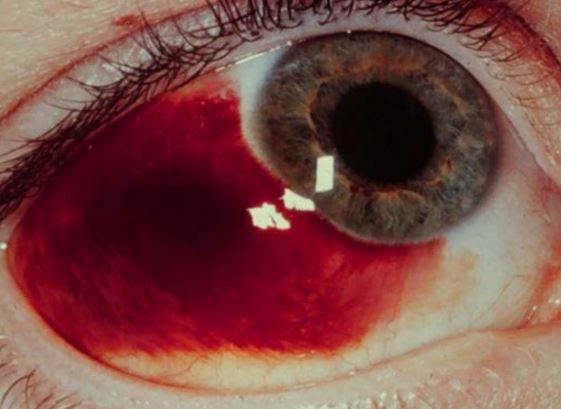Broken Blood Vessels in the Eye
What are Broken Blood Vessels in the Eye?
Broken blood vessels in an eye are known as subconjunctival hemorrhage. This happens when a very small blood vessel breaks just below the clear surface of the eye. Even a little amount of blood could spread out a lot in the small space.

A person with subconjunctival hemorrhage might not realize that a blood vessel busted until the person looks in the mirror and see. The white part of the eye will appear as dark red or bright red patch. The conjunctiva is the transparent tissue that lines the interior part of the eyelids and coats the white of the eye which is called the sclera.
It cannot easily absorb the blood right away, so in return, the blood gets trapped under the clear surface. Some people experiencing broken blood vessels in the eye may worry with it, but it commonly disappears in a span of one to two weeks and it is considered harmless.
Symptoms of Broken Blood Vessels in the Eye
For most cases of subconjunctival hemorrhage, no other symptoms are associated with it other than spotting blood over the top of the white part of the eye.
Usually, only one eye is affected that is red in color and usually feels slightly irritated. When the bleeding happens for the first time, the person may feel a slight pressure around the eye and detect a sense of fullness below the lid or in the eye. As the hemorrhage occurs, no blood will exit from the eye and it will look larger in the first 24 hours and then slowly decreases in size as blood is drawn in.
On numerous occasions, no other symptoms are present. No changes in vision should be felt or any pain in the eye. The affected eye will appear to have a bright red patch while the rest of the eye looks normal. If the hemorrhage does not heal within two weeks or if it had occurred numerous of times already, call an ophthalmogist.
Go to a physician right away if these symptoms are experienced:
- Pain in the eye
- History of trauma, high blood pressure, and a bleeding disorder
- If the blood in the eye occurred due to a skull injury since the bleeding could be caused by the brain
- Any changes in vision
Causes
The causes for this condition are sometimes unknown but subconjunctival hemorrhage typically prevails without causing any harm to the eye. Another possible reason is that it resulted after a strong cough or sneeze that prompts the blood vessel to break.
Other possible causes include:
- Lifting heavy things
- Vomiting
- Rubbing of the eyes after inserting contact lenses
- Lying on an up-side down position that increases pressure in the veins
- Outside eye infection wherein a bacteria weakens the walls of tiny blood vessels below the conjunctiva
- Medical disorder
- Traumatic events concerning the eye or head
- After a surgical operation of the eyelid or eye
Diagnosis
An eye doctor or an ophthalmologist will diagnose subconjunctival hemorrhage by looking at the patient’s eye and frequently needs no other tests. Even so, the physician may still ask some questions about all the symptoms experienced and the patient should tell the physician everything especially if any recent or uncommon bleeding, or other injuries regarding the eye had occurred.
An examination of the eye can also be performed and the blood pressure is checked as well. For some cases, the physician might ask the patient to give a blood sample to test for some bleeding disorders. If the hemorrhage is caused by trauma, a more rigorous examination will be done.
How are Broken Blood Vessels in the Eye Treated?
Most of the time, no treatment is required since subconjunctival hemorrhage commonly resolves on its own. If there are any mild irritations, artificial tears that can be bought over-the-counter could be used and applied to the eye without having an eye-patch. Aspirin, anticoagulant, or warfarin and any other medications that might trigger bleeding should be avoided.
If any are taken, make sure to consult a physician first if it is safe or not. If trauma is the cause, other treatments should be determined first by an ophthalmologist. The physician can also prescribe antibiotic drops or ointment if the hemorrhage is due to an external infection.
The condition usually recovers completely in a short-period of time without any long-term complications. It is normal that subconjunctival hemorrhage changes from red to yellow in color as it heals.
Pictures


References
- http://www.mayoclinic.org/diseases-conditions/subconjunctival-hemorrhage/basics/definition/con-20029242
- Subconjunctival Hemorrhage Causes and Treatment at http://www.medicinenet.com/subconjunctival_hemorrhage/article.htm
- http://www.healthline.com/health/subconjunctival-hemorrhage#Overview1
- Robert H. Grahamn (February 2009). “Subconjunctival Hemorrhage”. emedicine.com. Retrieved 23 November 2010.
- Bruce M. Rothschild (December 17, 2008). “Scurvy”. eMedicine.com. Retrieved 23 November 2010.
- Spitzer S. G, Luorno J., Noël L. P ( 2010). “Isolated subconjunctival hemorrhages in nonaccidental trauma”. ncbi.nlm.nih.gov. Retrieved 23 November 2010.
